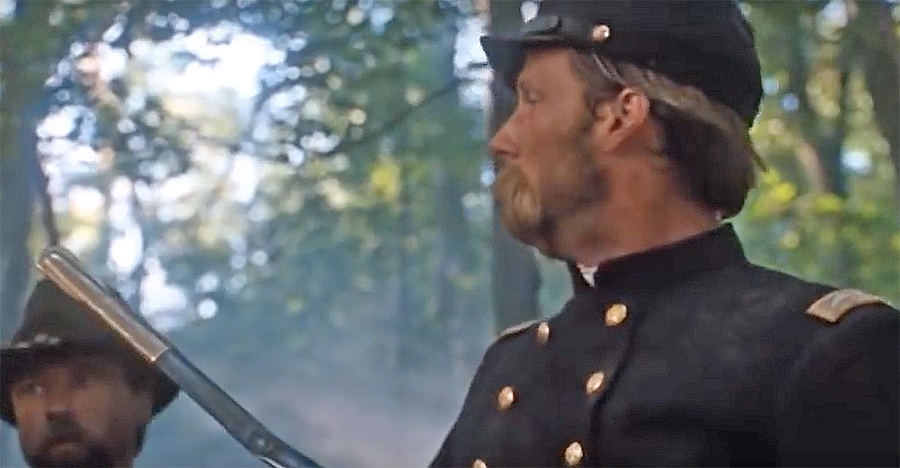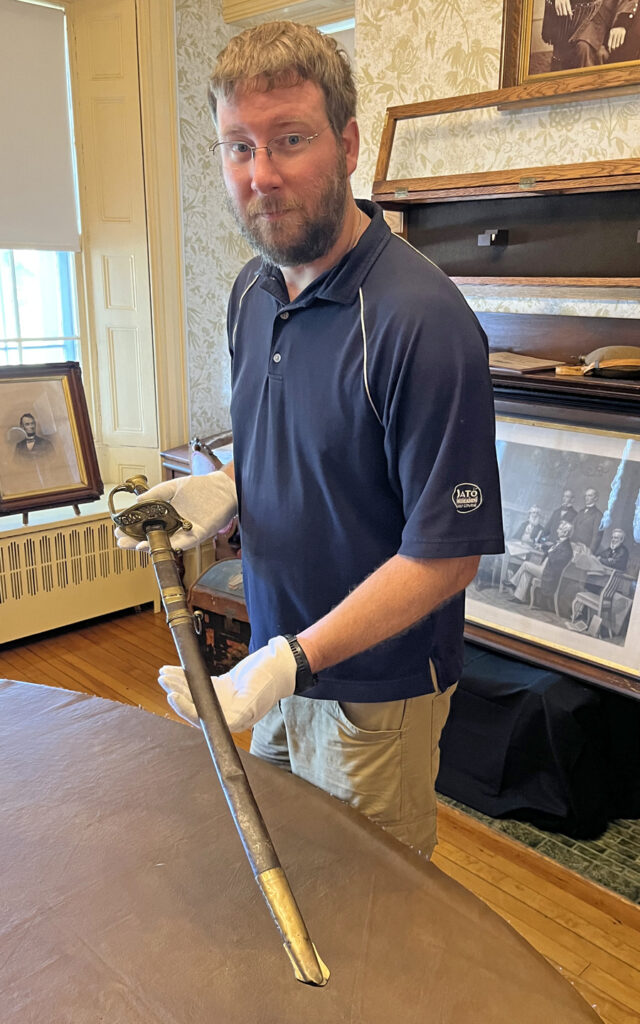The Movie Gettysburg and Chamberlain’s Historically Inaccurate Knock-Down Scene
As the 20th Maine Infantry Regiment and the 15th and 47th Alabama infantry regiments battle on Little Round Top in the 1993 movie Gettysburg, a Confederate shoots at the Yankees. His bullet strikes down Col. Joshua L. Chamberlain (actor Jeff Daniels).
He slowly stands, searches for a wound, and discovers that the bullet struck and dented his scabbard about a foot from its tip. The blow hurled Chamberlain to the ground.

Gettysburg fans familiar with the Chamberlain knock-down scene may not realize the historical inaccuracy that occurs when the colonel lifts his scabbard into view. The dent’s in the wrong place. The bullet actually struck and dented the scabbard between its two rings; the blow slammed the scabbard into the colonel’s hip and knocked down Chamberlain.
How do we know? Because the sword and scabbard still exist.
Chamberlain, of course, went on to other battles. The sword went with him, albeit after being repaired. The general now lies buried in the family lot at Pine Grove Cemetery in Brunswick. His sword is now displayed at the Bangor Historical Society’s Thomas Hill House in Bangor, Maine. The dented metal was pushed back even with the scabbard’s exterior, and the repaired dent was reinforced with two brass rings. They’re still there for visitors to see.

The sword and scabbard came to the BHS through a Chamberlain niece and her close friend. While the history of Chamberlain’s hometown, Brewer, recalls both, post-Civil War lore does not, so let me introduce the niece who preserved the sword and the friend who placed it with the Bangor Historical Society.
Alice Farrington was the daughter of Chamberlain’s only sister, Sarah “Sae” Brastow Chamberlain, born in Brewer on November 2, 1836. She later married Charles Oliver Farrington, and the couple had five children:
• John Chamberlain Farrington. Born in Brewer in June 1868, he died in mid-October 1869.
• Alice Mary Farrington. Her parents’ only daughter, Alice was born in Brewer on December 7, 1869 and died there on December 12, 1960. When she was young, she broke a hip while sliding on snow-covered Silk Street in Brewer, and the doctor did not properly set the hip. Afterwards Alice used a cane the rest of her life. Educated at Pomona College in Claremont, California, she never married.
• Charles Chamberlain Farrington. Born in Brewer in mid-June 1874, he died there in late July 1876.
• Lawrence Joshua Farrington. Named for his mother’s oldest brother, Lawrence was born in Brewer in late August 1875. He died in late April 1876.
• Dana Chamberlain Farrington. Born in Brewer in late June 1878, he died in Brewer at age 47 on October 3, 1925.
Joshua Chamberlain, of course, had settled in Brunswick long before the Farringtons were married. He and his wife, Frances “Fanny” Adams, also had five children, and as with the Farringtons’ five offspring, only two lived to adulthood.

Joshua occasionally visited his parents and sister in Brewer as the years passed. He and Sae frequently wrote each other, and she saved many of his letters, which Alice kept after her mother died. The general had also left with Sae the sword he wore while the 20th Maine Infantry Regiment defended Little Round Top on July 2, 1863.
A longtime Alice Farrington friend was Charlotte Hardy, sister of well-known Brewer historian Fannie Hardy Eckstrom. Alice lived in the Chamberlain family’s house at 80 Chamberlain Street in Brewer until her death. Afterwards the letter collection went to the Pejepscot Historical Society in Brunswick, and the Joshua Chamberlain sword and scabbard went to Hardy.
She donated both to the Bangor Historical Society on May 23, 1963. A hand-written note indicates this was the “sword worn by Gen’l Joshua Chamberlain in the Civil War.”
The accession file (No. 54) indicates the artifact is a “sword or saber in scabbard.” The latter item “is metal with brass bands and rings, brass tip has a hole in it, a break 2/3 [the] way up is mended with metal bound with brass strips.” The “sword hilt has openwork flowers cast and etched and ‘US,’ slit for decorative braid, grip is lizard skin bound with wire.”
The sword blade is “1” [inch] wide on average, overall length 35½ [inches], with “no engraving on blade,” according to accession file 54. The overall condition of the sword and scabbard is “fair.” The sword was “steel wooled, oiled & polished” on June 1, 1977.
Visitors to the Thomas Hill House often ask to see the sword and scabbard, which are kept in a locked display case in the GAR Room.
Author’s note: This post was also published today at Maine at War.
Nice piece … many thanks for the great story and for setting the cinematic record straight … and talk about “what ifs” … what if that Confederate round was an inch on either side of the scabbard? Colonel Chamberlain would have gone down with a grievous wound … he likely looses his leg … and we probably don’t have the same Joshua Chamberlain we have today.
Interesting article-thank you.
You are welcome. Thank you for reading it!
Great post, Brian. I always wondered if Chamberlain’s account of his scabbard wound matched up with the artifact itself.
Great post, Brian. I always wondered whether Chamberlain’s account of his LRT wound matched up with the artifact.
Well, the movie is based on a novel. ‘Artistic liberties’ were taken. Dramatic effect was amplified. But still I DO like the movie!!